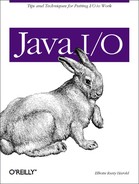As well as the ObjectInputStream and
ObjectOutputStream classes, the
java.io package also provides
ObjectInput
and ObjectOutput
interfaces:
public interface ObjectInput extends DataInput public interface ObjectOutput extends DataOutput
These interfaces are not much used in Java 1.1 and 2. The only
classes in the core API that actually implement them are
ObjectInputStream and
ObjectOutputStream. However, several methods used
for customization of the serialization process are declared to accept
ObjectInput or ObjectOutput
objects as arguments, rather than specifically
ObjectInputStream or
ObjectOutputStream objects. This provides a little
wiggle room for Java to grow in unforeseen ways.
The ObjectInput interface declares seven methods,
all of which ObjectInputStream faithfully
implements:
public abstract Object readObject() throws ClassNotFoundException, IOException public abstract int read() throws IOException public abstract int read(byte[] data) throws IOException public abstract int read(byte[] data, int offset, int length) throws IOException public abstract long skip(long n) throws IOException public abstract int available() throws IOException public abstract void close() throws IOException
The readObject() method has already been discussed
in the context of object input streams. The other six methods behave
exactly as they do for all input streams. In fact, at first glance,
all these methods except readObject() appear
superfluous, since any InputStream subclass will
possess read(), skip(),
available(), and close()
methods with these signatures. However, this interface may be
implemented by classes that aren’t subclasses of
InputStream.
The
ObjectOutput interface declares the following six
methods, all of which ObjectOutputStream
faithfully implements. Except for writeObject(),
which has already been discussed in the context of object output
streams, these methods should behave exactly as they do for all
output streams:
public abstract void writeObject(Object o) throws IOException public abstract void write(int b) throws IOException public abstract void write(byte data[]) throws IOException public abstract void write(byte[] data, int offset, int length) throws IOException public abstract void flush() throws IOException public abstract void close() throws IOException
ObjectInput and ObjectOutput
extend DataInput and
DataOutput. Thus, as well as the methods declared
outright, classes that implement ObjectInput must
provide these additional methods as well:
public abstract void readFully(byte data[]) throws IOException public abstract void readFully(byte data[], int offset, int length) throws IOException public abstract int skipBytes(int n) throws IOException public abstract boolean readBoolean() throws IOException public abstract byte readByte() throws IOException public abstract int readUnsignedByte() throws IOException public abstract short readShort() throws IOException public abstract int readUnsignedShort() throws IOException public abstract char readChar() throws IOException public abstract int readInt() throws IOException public abstract long readLong() throws IOException public abstract float readFloat() throws IOException public abstract double readDouble() throws IOException public abstract String readLine() throws IOException public abstract String readUTF() throws IOException
Classes that implement ObjectOutput must provide
these additional methods:
public abstract void write(int b) throws IOException public abstract void write(byte[] data) throws IOException public abstract void write(byte[] data, int offset, int length) throws IOException public abstract void writeBoolean(boolean v) throws IOException public abstract void writeByte(int b) throws IOException public abstract void writeShort(int s) throws IOException public abstract void writeChar(int c) throws IOException public abstract void writeInt(int i) throws IOException public abstract void writeLong(long l) throws IOException public abstract void writeFloat(float f) throws IOException public abstract void writeDouble(double d) throws IOException public abstract void writeBytes(String s) throws IOException public abstract void writeChars(String s) throws IOException public abstract void writeUTF(String s) throws IOException
As I noted back in Chapter 7, there’s a bit
of asymmetry between the DataInput and
DataOutput interfaces.
DataOutput declares the three
write() methods you expect to find in output
streams, but DataInput does not declare the three
corresponding read() methods you expect to find in
input streams. This asymmetry does not carry over into the
ObjectInput and ObjectOutput
interfaces where ObjectInput has
read() methods and ObjectOutput
has write() methods.
By extending DataInput and
DataOutput, ObjectInput and
ObjectOutput guarantee that their implementers are
able to read and write both objects and primitive types like
int and double. Since an object
may contain fields of primitive types, anything that has to read or
write the state of an object also has to be able to read or write the
primitive fields the object contains.
